Disclosure: We may earn commissions if you purchase products after clicking on a link from our site.
Have you always wanted to learn how to catch triggerfish? Do you want to experience catching triggerfish? Triggerfish is an aggressive and hard-fighting fish. Triggerfish are challenging to catch as it has small mouth and teeth that it uses to nibble at bait and get away with it.
In this article, we discuss how to catch triggerfish, fishing tackle for catching triggerfish, the best baits for catching triggerfish, and other fishing tips to improve your chances of catching this hard-fighting and tasty fish.
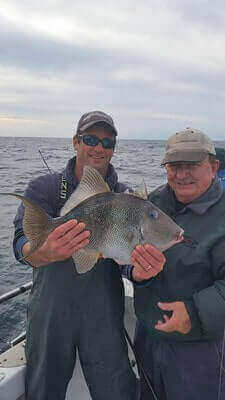
Table of Contents
How To Catch Triggerfish
1. Drifting
Drift fishing is a versatile method that can be effective for catching triggerfish in a variety of environments. Anglers employ this technique by allowing their bait to drift naturally with the current while covering a wide area.
This method is particularly useful when targeting triggerfish over expansive areas such as reefs or wrecks. Anglers can use live bait, cut bait, or artificial lures depending on their preference and the conditions. By drifting their baits at different depths and varying their drift speed, anglers can increase their chances of enticing a strike from triggerfish.
Drift fishing requires anglers to maintain control of their lines and stay attentive to bites while allowing their baits to move naturally with the current. For more information on how to catch triggerfish using drift fishing techniques, visit Fisheries.noaa.gov.
2. Chumming
Chumming is another fishing technique that is used to catch triggerfish. When chumming, anglers will put strips or little chunks of bait on their lines and drop them in the water to attract fish. When the fish discover the bait, they will all go after it and this way anglers can catch them. It is an effective way to attract fish when you are learning how to catch triggerfish.
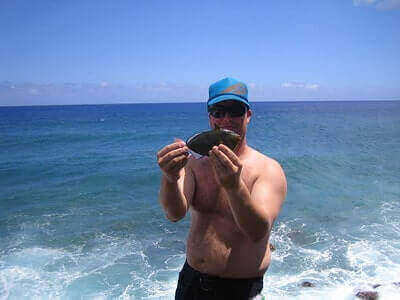
3. Bait Casting
Bait casting is another fishing method used by anglers to catch triggerfish. Bait casting is a regular fishing method used by anglers when fishing for many fish. You set your bait on the line and cast it into the water. When you get tension or bite on the line, you reel it in quickly. When you are learning how to catch triggerfish, bait casting is one of the easiest methods to use.
4. Bottom Fishing
Bottom fishing is a popular method for catching triggerfish. Anglers use this technique by dropping their baited hooks into the seabed where triggerfish often dwell. Once the bait reaches the bottom, anglers wait patiently for a triggerfish to take the bait. Common bait options include shrimp, squid, and cut bait. Triggerfish are known for their sharp teeth and strong jaws, so using a sturdy fishing rig is advisable to prevent break-offs.
This method requires anglers to have a good understanding of the underwater terrain and the behavior of triggerfish to position their bait effectively. By employing this method, anglers can successfully target triggerfish in their habitat. For more information on how to catch triggerfish using bottom fishing techniques, visit Fisheries.noaa.gov.
5. Jigging
Jigging is another effective technique for targeting triggerfish. Anglers use specialized jigs, typically made of metal or synthetic materials, designed to mimic the movement of small baitfish or crustaceans. By jerking or “jigging” the rod tip up and down, anglers impart an enticing motion to the jig, attracting triggerfish to strike.
This method is particularly effective when triggerfish are holding in deeper waters or around underwater structures such as reefs and wrecks. Anglers can vary the speed and rhythm of their jigging to find what triggers the most bites. Common jigging baits for triggerfish include bucktail jigs, butterfly jigs, and vertical jigs. Successful jigging for triggerfish requires patience, finesse, and the ability to read underwater conditions. To learn more about how to catch triggerfish using jigging techniques, visit Fisheries.noaa.gov.
Triggerfish Tackle Setup
A conventional fishing rod and reel can be used for triggerfish fishing. A 7-foot medium-action conventional rod with a 2230 series reel and a 300-pound braided line will work for anglers who prefer conventional fishing gear.
Similarly, a 7-foot medium action spinning rod with a 3000 to 4000 series reel spooled up with a 20-pound braided line works for anglers who prefer spinning tackle. The tackle for catching triggerfish is not complicated. It is the regular tackle you will use for catching other fish like grouper or red snapper.
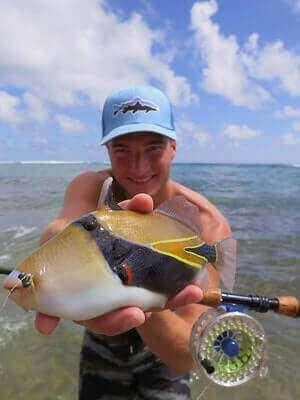
How To Catch Triggerfish From The Shore
Triggerfish will move up in the water column to feed on forage that is in the weeds. You can catch triggerfish from the shore using a rig with a hook or a split shot or two will get the job done. Spinning tackle will be a better bet than conventional rigs. Catching triggerfish from the surface can be easier for anglers as it searches for prey in the weeds.
Best Baits For Triggerfish
1. Squid
Squid is a highly effective bait for catching triggerfish due to its strong scent, durability, and attractive appearance underwater. Triggerfish are known to be opportunistic feeders and are attracted to the scent and movement of squid.
When using squid as bait for triggerfish, anglers often rig it on a hook in a way that allows it to flutter naturally in the water, mimicking the movements of live prey. Squid can be used whole or cut into smaller pieces depending on the size of the target fish and the fishing conditions.
Additionally, squid holds up well on the hook, making it a practical choice for bottom fishing where triggerfish are commonly found. Its versatility and effectiveness make squid a popular bait choice among anglers targeting triggerfish in both saltwater and freshwater environments.
2. Sardines
Sardines are a popular bait choice for anglers targeting triggerfish due to their oily flesh, strong scent, and natural appearance underwater. Triggerfish are known to be opportunistic feeders, and they are attracted to the scent and taste of sardines. When using sardines as bait for triggerfish, anglers often rig them whole or in chunks on a hook to mimic the natural prey of triggerfish.
The oily nature of sardines releases scent and flavor into the water, which can attract triggerfish from a distance. Sardines are particularly effective when bottom fishing, as they can be easily presented near rocky structures or reefs where triggerfish often congregate.
Additionally, sardines are relatively durable and stay on the hook well, making them practical for extended fishing sessions. Overall, sardines are a versatile and effective bait choice for anglers targeting triggerfish in various saltwater environments.
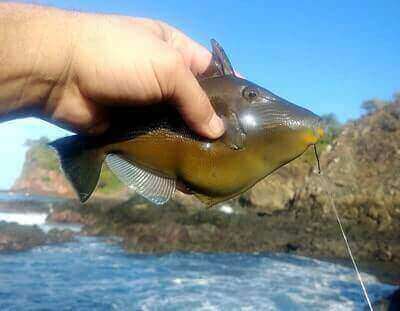
3. Clams
Clams are a natural and effective bait choice for anglers targeting triggerfish. These bivalve mollusks are readily available in coastal areas and are known to attract a variety of saltwater species, including triggerfish. Their scent and texture make them appealing to triggerfish, which are bottom-dwelling fish often found near rocky structures, reefs, and underwater features.
Anglers typically rig clams on a hook, either whole or in pieces, to mimic natural prey and maximize their attractiveness to triggerfish. Clams can be threaded onto a hook securely, ensuring they stay intact during casting and fishing. When fishing with clams for triggerfish, anglers often employ bottom fishing techniques, allowing the bait to settle near the sea floor where triggerfish are known to feed.
Clams are also durable and can withstand the attention of smaller bait-stealing fish, making them ideal for extended fishing sessions. Overall, clams are a reliable and readily available bait option for anglers seeking to catch triggerfish in coastal waters.
4. Oysters
Oysters can be a viable bait option for anglers targeting triggerfish in saltwater environments. These bivalve mollusks possess a strong aroma and rich flavor that can attract a variety of fish species, including triggerfish. Anglers can use oysters either whole or in pieces as bait, depending on the size of the fish they are targeting and the fishing technique being employed.
Oysters can be securely threaded onto a hook to ensure they stay intact during casting and fishing. When fishing with oysters for triggerfish, anglers often utilize bottom fishing techniques, allowing the bait to settle near the seabed where triggerfish are commonly found. Oysters are particularly effective when fishing around rocky structures, reefs, and underwater features where triggerfish congregate.
Additionally, oysters are durable and can withstand the attention of smaller bait-stealing fish, making them suitable for extended fishing sessions. Overall, oysters can serve as a reliable and enticing bait option for anglers seeking to catch triggerfish in coastal waters.
5. Octopus
Octopus is a highly effective bait choice for anglers targeting triggerfish in both saltwater and reef environments. Known for its strong scent and texture, octopus can attract triggerfish from a distance, making it a popular option among anglers. When using octopus as bait, anglers typically cut it into small, bite-sized pieces or strips to expose its scent and maximize its effectiveness.
These pieces can then be securely threaded onto a hook or attached to a bait rig for casting or bottom fishing. Octopus is particularly appealing to triggerfish due to its natural movement and resemblance to the crustaceans and other small prey that triggerfish feed on.
Anglers often find success with octopus bait when fishing near rocky outcrops, reefs, and other underwater structures where triggerfish are commonly found. Its durability and resistance to bait-stealing fish make octopus a reliable option for extended fishing sessions. Overall, octopus serves as a versatile and enticing bait choice for anglers looking to catch triggerfish in coastal and offshore waters.

6. Sand Dollar
Sand dollars are not commonly used as bait for triggerfish, as they lack the scent, texture, and appeal that triggerfish typically seek out. Triggerfish are primarily carnivorous and feed on small crustaceans, mollusks, and other marine invertebrates found on the ocean floor.
While sand dollars are marine animals related to sea urchins and starfish, they are not known to be effective bait for fishing. Instead, anglers targeting triggerfish typically opt for baits with strong scents and textures, such as squid, sardines, clams, octopus, or shrimp. These baits are more likely to attract triggerfish and entice them to bite. Sand dollars, while fascinating marine creatures, are better suited for ecological observation rather than as bait for fishing endeavors targeting triggerfish.
7. Sea Urchin
Sea urchins can indeed be effective bait for catching triggerfish, especially in regions where triggerfish are abundant and foragers for various marine invertebrates. Triggerfish are known to feed on a variety of prey, including crustaceans, mollusks, and smaller fish. Sea urchins, being part of their natural diet, can be enticing to triggerfish due to their rich taste and texture.
Anglers often use fresh or frozen sea urchins as bait, either whole or cut into smaller pieces to attract triggerfish. When preparing sea urchins as bait, it’s essential to remove the spines and hard outer shell to expose the soft, fleshy interior, which is what triggerfish are after.
Additionally, securing the sea urchin bait properly on the hook ensures it stays intact and effectively attracts triggerfish. Overall, sea urchins can be a valuable bait option for anglers targeting triggerfish in coastal waters.
8. Fiddler Crabs
Fiddler crabs can be an effective bait for catching triggerfish, particularly in areas where these fish are abundant and forage along the seabed for various crustaceans and invertebrates. Triggerfish are known to have a diverse diet, including crabs, mollusks, and small fish, making fiddler crabs a suitable option for bait.
These crabs are often found in intertidal zones and marshy areas, making them accessible to anglers who frequent coastal waters. When using fiddler crabs as bait, anglers typically rig them onto hooks by piercing through the crab’s body or securing them with thread to prevent them from easily falling off.
Fiddler crabs are attractive to triggerfish due to their movement and scent, mimicking natural prey items found in the triggerfish’s environment. As a result, anglers seeking to catch triggerfish often find success when using fiddler crabs as bait, especially when presented effectively along the seabed or near underwater structures where triggerfish are known to inhabit.
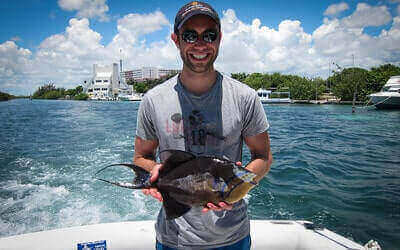
9. Mollusks
Mollusks can serve as effective bait for triggering bites from triggerfish, which are known for their preference for various types of marine invertebrates. Mollusks such as clams, oysters, and mussels are often used by anglers targeting triggerfish due to their availability and appeal to these species. Triggerfish are bottom feeders and frequently forage along the seabed for crustaceans, mollusks, and other small marine organisms.
Therefore, presenting mollusks as bait can entice triggerfish to bite, especially when rigged properly on fishing hooks to mimic natural prey items. Anglers typically secure mollusks onto hooks using methods such as threading or pinning to ensure they remain intact during casting and retrieval.
The scent and texture of mollusks make them attractive to triggerfish, prompting strikes and increasing the likelihood of a successful catch. When fishing for triggerfish, especially in coastal areas with abundant mollusk populations, using mollusks as bait can be a fruitful strategy for anglers aiming to land these elusive and prized fish.
Where To Find Triggerfish
Triggerfish prey on crustaceans and other marine life that reside at the bottom. Therefore, you will find triggerfish at the bottom hiding in structures like ledges, wrecks, artificial reefs, buoys, limestone outcroppings, and other structures that they can use to hide and ambush their prey.
When you are looking for triggerfish, move your boat slowly and when you find these structures, drop your bait to the bottom to target triggerfish.
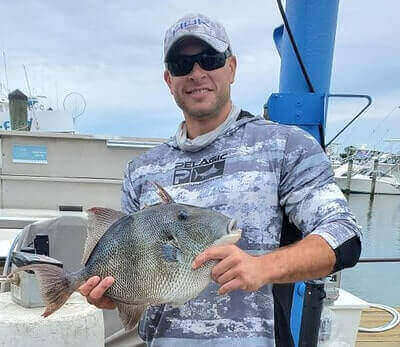
Triggerfish Fishing Tips
- Anglers implement a technique called “bucketing” to catch triggerfish when they don’t bite. They like to swim and hide inside the flotsam. Anglers use that knowledge to their advantage and fill a bucket with water and add some lead and let it sink next to the boat. There is a good chance that the triggerfish will into the bucket and you can just pull it up and you might have one in the bucket.
2. Triggerfish have small mouths therefore properly rigging your bait is very important for catching them. They are notorious for nibbling bait off without getting hooked.
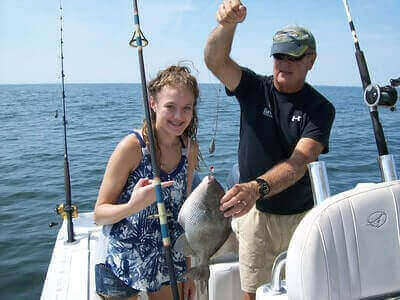
3. Triggerfish can be found close to shore sometimes, making them good targets for anglers with smaller boats. They often come up in the water column as they feed on the forage in the weeds.
4. Triggefish like to reside around structures like ledges, coral, artificial reefs, wrecks, or the natural hard bottom. They use the structures at the bottom to wait in ambush for their prey.
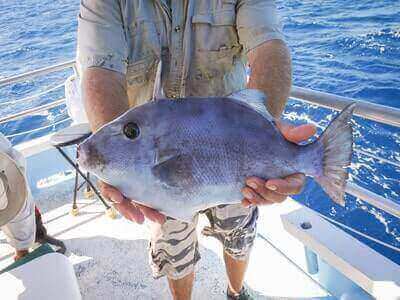
5. Try to locate smaller ledges and patches of hard bottoms that are not discovered by anglers fishing for grouper and other fish. These unnoticed structures are good areas to target triggerfish.
6. Use small hooks when fishing for triggerfish as they have small mouths and you want to get your hook in. A hook size of 2/0 usually works when fishing for triggerfish.
7. When you are learning how to catch triggerfish, if you are searching for triggerfish and are finding red snappers and groupers in the area, then there is a good chance that triggerfish are also in that area.
The Bottom Line
Triggerfish is an aggressive and hard-fighting fish that can be difficult to catch as it nibbles at bait until it unhooks the bait and gets away with it. They are often found at the bottom where they prey on crustaceans and other marine life found there.
In this article, we discussed how to catch triggerfish as well as the fishing methods, fishing tackle, and other information to help you be more successful when fishing for triggerfish. If you also fish for grouper, red snapper, halibut, and tarpon, you can also read how to catch grouper, how to catch red snapper, how to catch halibut, how to catch burbot, how to catch triggerfish, and how to catch tarpon.